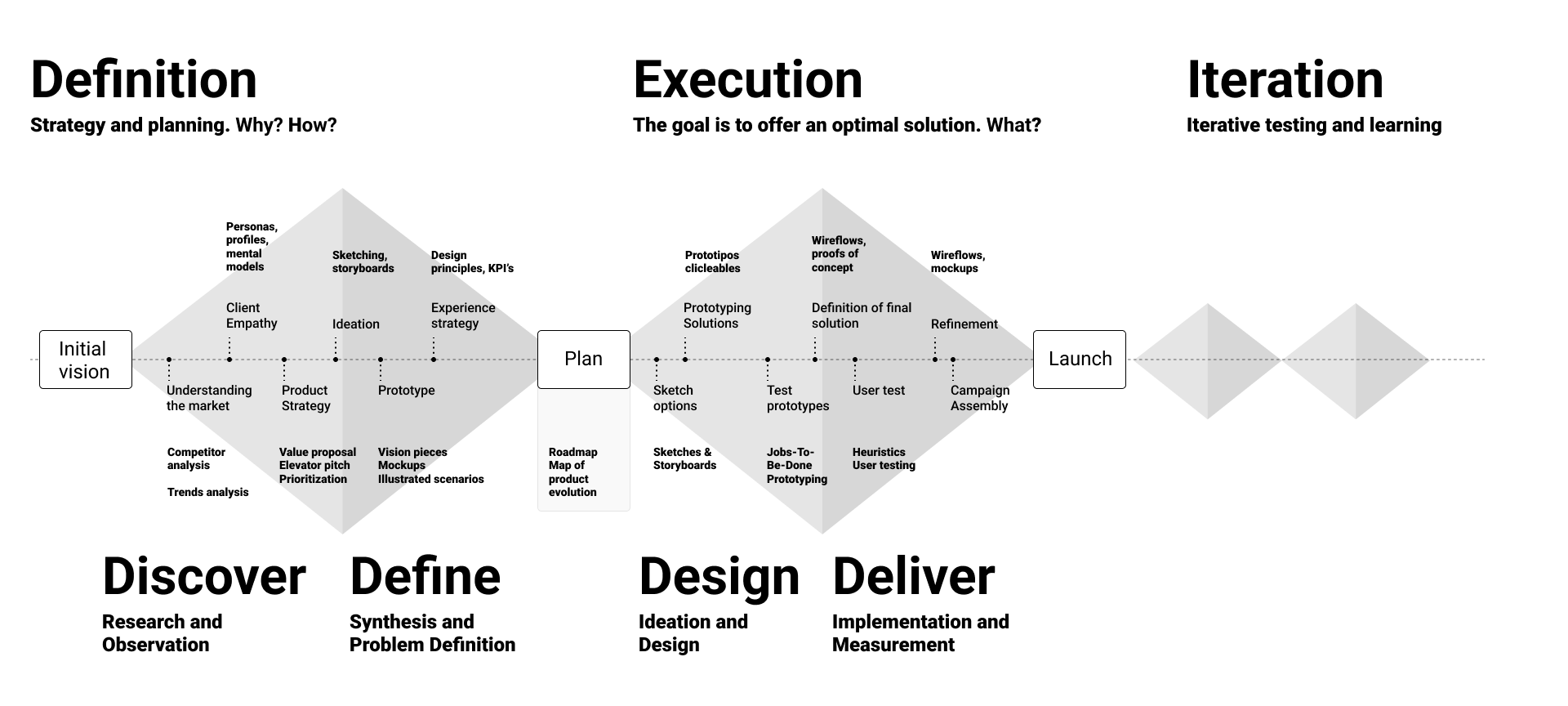Design Process
Mia Design Studio's design process is built to tackle complex challenges and deliver impactful, human-centered solutions. We prioritize transparent collaboration, ensuring every step aligns with your vision and business goals.
Having developed our own products, we deeply understand the challenges and struggles you face. This unique perspective enables problem-solving with genuine empathy and a comprehensive understanding of your needs.
We offer a comprehensive approach that covers the entire product lifecycle, from initial concept to ongoing refinement and strategic evolution.
8-Step Design Process

Our design process is based on the powerful framework of the Double Diamond Theory. This is a human-centered approach consisting of four phases: Discover, Define, Design, and Deliver. In each phase, we alternate between "divergent" (exploring broadly) and "convergent" (focusing narrowly) thinking to provide innovative solutions that meet true user needs.
1st Diamond: Discovery & Definition
Discover
In this phase, we gather as much information and as many perspectives as possible to broadly explore the overall problem.
1. Contact
Purpose: To establish initial contact and understand the basic needs and scope of your project.
Content: This phase involves your first reach-out, where we gather preliminary information about your project, challenges, and goals through an inquiry form or direct communication.
2. Discovery
Purpose: To gain a deep understanding of your business, target users, market, and existing pain points.
Content: We conduct market analysis, competitive benchmarking, user interviews, surveys, and usability testing to uncover critical insights and opportunities.
Define
We analyze insights from the Discover phase to identify the most critical challenges and opportunities, defining a clear direction for the project.
3. Consultation
Purpose: To synthesize research findings, define project scope, establish clear goals, and formulate a strategic roadmap.
Content: Through workshops and discussions, we align on strategies, prioritize features, define KPIs, and outline the project timeline.
2nd Diamond: Design & Delivery
Design
For the defined problem, we broadly explore diverse solutions and ideas, seeking creative approaches.
4. Concept Development
Purpose: To translate strategy into tangible design concepts, focusing on user flow, information architecture, and visual direction.
Content: We create wireframes, user flows, and mockups, exploring various design solutions and gathering early feedback to refine concepts.
5. Production
Purpose: To execute approved design concepts, building the full user interface and experience.
Content: This phase includes detailed UI design, interaction design, prototyping, and close collaboration with development teams to ensure design integrity during implementation.
Deliver
We focus on the most viable and effective solutions, shaping them into concrete products or services for release.
6. Delivery
Purpose: To formally transfer completed design assets and documentation to the client.
Content: Provision of final design files, prototypes, asset libraries, and comprehensive documentation for development teams, ensuring a smooth transition.
7. Post-Launch Support
Purpose: To monitor post-launch performance, propose improvements, and maintain strong relationships.
- Performance Monitoring: Analyzing key metrics like website analytics, user behavior, and conversion rates.
- Bug Fixing / Maintenance: Addressing post-launch issues and performing routine maintenance.
- Iterative Improvements: Recommending data-driven enhancements and new features based on user feedback and performance data.
- Client Relationship Management: Engaging in regular communication to foster long-term partnerships.
8. Design System
Purpose: To establish unified principles, components, and guidelines ensuring consistency, efficiency, and scalability for future design and development efforts.
- Brand Guidelines: Detailed rules for logo usage, color palettes, typography, and imagery, reflecting the brand's visual identity.
- UI Component Library: Definition and usage instructions for reusable UI components (buttons, forms, navigation, "etc.").
- Style Guide: Comprehensive guidelines for developers, covering coding standards, accessibility, and implementation best practices.
- Future Scalability: Enabling future design expansion and streamlining workflows for multiple designers and developers.
This Double Diamond framework allows us to not only create beautiful designs but also to deliver meaningful, sustainable solutions for both users and businesses.